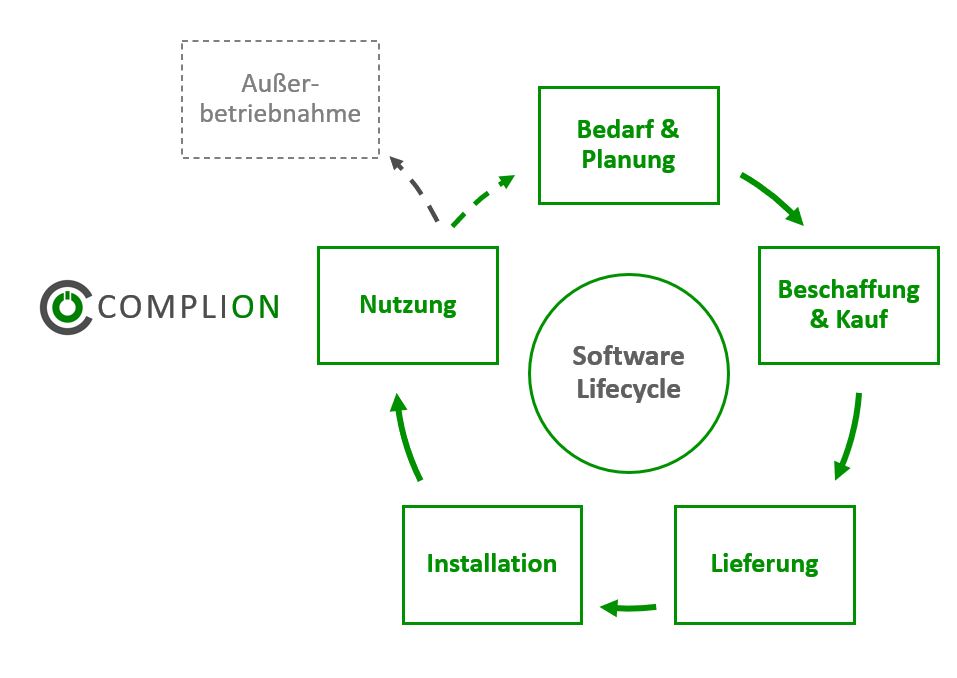
Software lifecycle management: from procurement to decommissioning
Discover the keys to effective software lifecycle management! From procurement to decommissioning - find out how you as a software asset manager can maintain control over the entire lifecycle of your software licenses.
Software plays a decisive role in the success of a company. Therefore, effective software lifecycle management is of paramount importance. As software asset managers, we are responsible for ensuring that an organization efficiently plans, procures, deploys, uses, maintains and ultimately decommissions its software licenses. Behind these trivial-sounding tasks lie complex activities. Only by paying attention to and integrating all activities can company resources be used efficiently. This requires a holistic strategy.

1. Demand & Planning
Requirements analysis and planning are crucial for software lifecycle management, as they ensure that the right licenses are procured at the optimal time and price. The complexity of this phase increases with the size of the organization and requires all units involved to be brought together. The challenge is to consider the different interests and framework conditions, whether within different specialist departments or due to legal requirements in different countries. Despite these challenges, it is essential to carry out a comprehensive analysis to ensure that the software licenses meet the needs of all relevant stakeholders.
2. Procurement & purchase
The procurement phase follows planning and includes the acquisition of required software licenses through direct purchases, license agreements or subscriptions. It is very important to ensure that these purchases are made in accordance with the previously defined plans and budgets and that they receive the approval of the central organizational units. Close cooperation with the purchasing department is essential here. It should also be noted that not procuring licenses is the easiest and most effective way to save company resources and optimize software usage. If the purchasing department also questions the necessity of procurements and examines alternative solutions, savings of up to 100% can be achieved through cost avoidance.
3. Delivery
The delivery and inventory of software licenses are crucial steps in license management. A thorough check of the delivered licenses ensures their completeness and compliance with requirements. Recording them in an inventory system enables efficient management throughout the company, which identifies bottlenecks, duplicate purchases or unused licenses and reduces costs. Qualified SAM tools are essential for correctly mapping license balances and clearly displaying license models. In addition, we are increasingly finding that companies are developing their own SAM tools to take account of their individual requirements, which are not met by proprietary software. The integration of license management into the delivery process is crucial to ensure complete documentation and effective administration.
4. Provision & Installation
The provision of software licenses is a crucial moment, but also a complex task. Depending on the degree of automation, this process can run more or less automatically, with rarely required products often becoming a challenge. Decentralized management of such niche products makes it difficult to access the required information. Release management is another important aspect that needs to be clarified before installation to avoid compliance violations and costs. Insufficient preparation can ultimately lead to higher costs and negate the original savings aspect.
5. Usage & Analysis
After installation, users regularly use the software, which represents an opportunity for license managers to demonstrate their expertise, especially in collaboration with IT controlling, in order to create transparency about software consumption and the associated costs. Suitable billing methods and awareness measures are important in order to sensitize users to responsible use. Product managers and key users are key supporters in interpreting software consumption, detecting errors and bottlenecks at an early stage and identifying optimization potential. Here, both the SAM tool and the SAM organization can prove their effectiveness and provide comprehensive support for company processes.
6. Decommissioning the software
Software asset management generally has no direct influence on the end of a software lifecycle. Nevertheless, it can also make a positive contribution in this phase through targeted measures. A level-headed approach is essential when decommissioning to ensure that historical data is retained. Many manufacturers offer attractive options for reactivating old licenses. This phase of the lifecycle provides an opportunity to revisit past decisions and optimize future strategies. Through thorough analysis and planning, companies can be better prepared for future changes and deal more effectively with the challenges of software management. This shows that software asset management can make an important contribution to the efficient use of resources and cost optimization not only during active operation, but also at the end of the life cycle.
The AI trends of the present and future will increasingly support the work of software asset managers. Nevertheless, the task will always be to react flexibly to changes, maximize efficiency and ensure compliance. The software lifecycle will most likely remain the same and attention to detail will always be part of the software asset manager's job.
Author: Volker Albrich